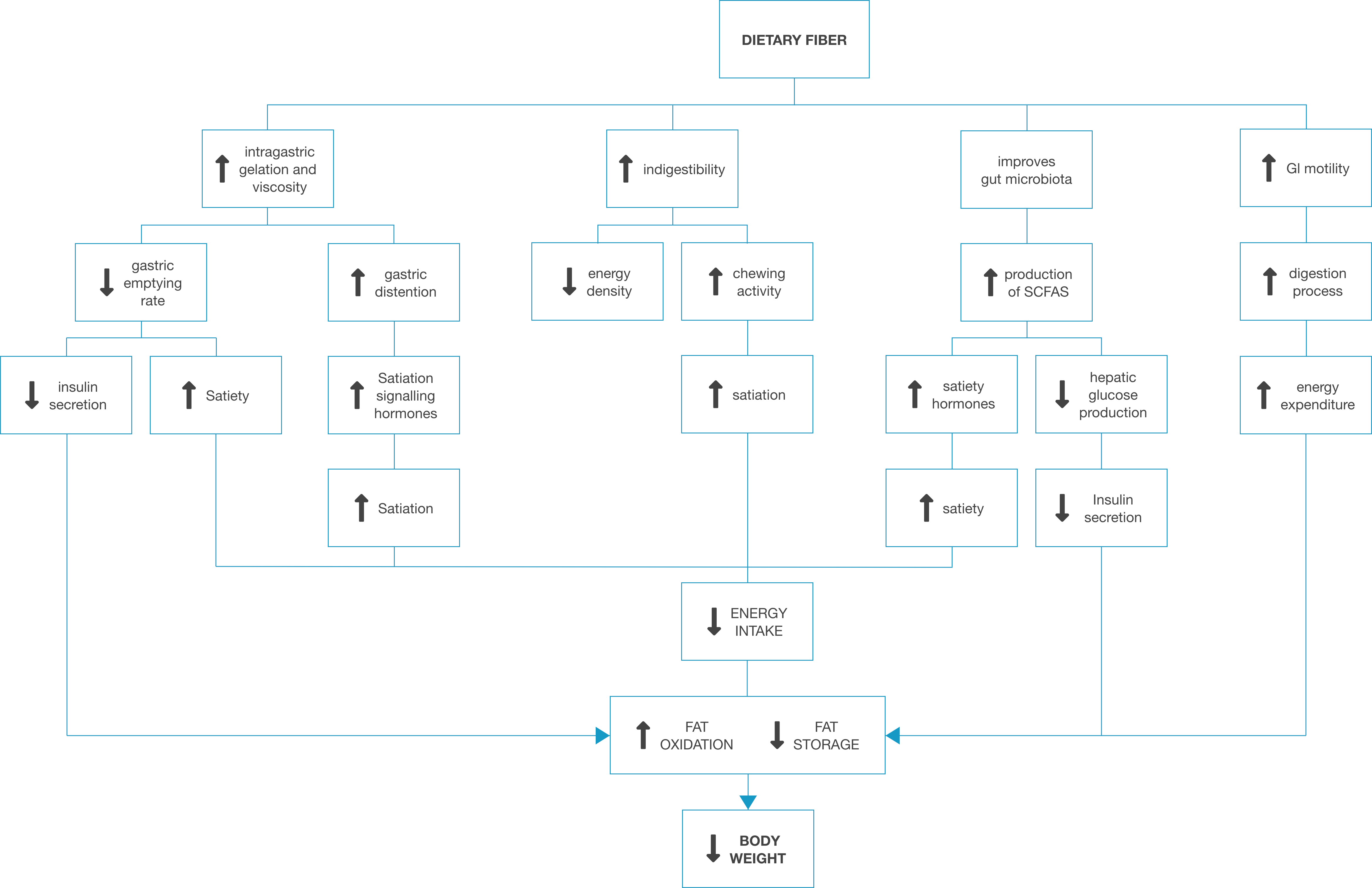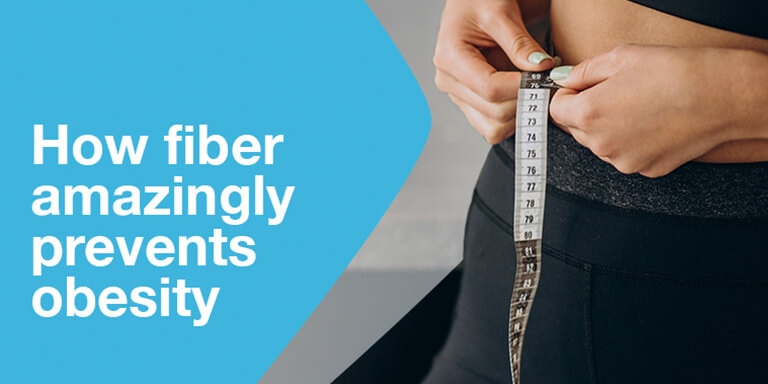Fiber A Day Keeps Obesity at Bay
In the Philippines, there is a high prevalence of getting obese and overweight. This is signified by the 2018-2019 Expanded National Nutrition Survey1 which reported that there is a 36.6% prevalence of overweight and obesity among adults 20 to 59 years old in the Philippines.
Based on the World Health Organization2 cut-off, a person with a Body Mass Index of ≥25.0 kg/m is considered overweight or pre-obese. The cut-off for Asia-Pacific is lower at ≥23.0 kg/m. This is because Asians generally have a higher percentage of body fat than Caucasian people of the same age, sex, and BMI. Also, the proportion of Asian people with risk factors for type 2 diabetes and cardiovascular disease is substantial even below the existing WHO BMI cut-off point of 25 kg/m. Thus, current WHO cut-off points do not provide an adequate basis for taking action on risks related to overweight and obesity in many populations in Asia.3
That being said, populations in the Asia-Pacific regions are at higher risk for lifestyle diseases and other noncommunicable diseases (NCDs) given their lower cut-off points for overweight and obesity. Seeing things play in the current health situation the entire world is experiencing, a recent study4 indicates that obesity puts patients at risk for severe COVID-19. By the numbers, 1 in 3 adults are at risk for these conditions. A true testament to the need for more discussion about obesity and how fiber can aid in solving this problem.
Table 1. Classification of Weight Status Based on BMI (Lim et al., 2017)
| Evaluation | BMI cut-off | |
|---|---|---|
| WHO | ASIA PACIFIC | |
| UNDERWEIGHT | < 18.5 | < 18.5 |
NORMAL | 18.5 - 24.9 | 18.5 - 22.9 |
| OVERWEIGHT | 25 - 29.9 | 23 - 24.9 |
| OBESE | ≥ 30 | ≥ 25 |
Overweight and obese children have a high chance to grow up as overweight and obese adults and are more prone to develop noncommunicable diseases (NCDs) and other life-long conditions, such as cardiovascular disease, diabetes, or mental disorders such as anxiety and depression5. Should correct nutrition start in childhood then? Even earlier: even before a mother becomes pregnant, correct nutrition should already be observed, with the first 1,000 days as the window of opportunity for life-long health.
Dietary Fiber: The Right Approach in Choosing the Right Food
A good strategy for overweight and obese patients is to take the approach to weight loss one component at a time. Special focus should be given to dietary fiber as a component of a balanced diet since it is one of the most important components in losing weight (Panlasigui, 2021).
The recommended dietary fiber intake for adults is 20-25 grams.6 In a real-table setup, one can achieve 20-25 grams of fiber by simply eating a serving or more of vegetables with their meals or around ½ cup (40 grams) of non-leafy vegetables and 1 cup (25 grams) for leafy vegetables. If individual preference is towards fruits, FNRI recommends two servings (45-300 grams, depending on fruit size and variety) of fruit daily.7
In the interest of diversifying the balanced diet, there are other foods aside from fruits and vegetables that carry dietary fiber, such as legumes and nuts: peanuts, kasuy (cashews), squash seeds, and buto ng pakwan (watermelon seeds); and whole grains: brown rice and corn. When baking at home, it is worth considering using whole wheat flour cake recipes to boost the dietary fiber content of pastries. One can also consider using fresh fruit and jam, which has around 1.1 grams of fiber per 100 grams, to flavor the cake.
Table 2. Common Sources of Dietary Fiber in the Filipino Diet (ASEAN Food Composition Database, 2014)
Effects of Fiber on Weight Management: Knowledge Essentials
The health benefits of fiber can be attributed to several plausible mechanisms of action, which have been supported by evidence from human and animal studies. Listed below are the researched benefits of fiber:
- Dietary fiber can increase satiety and satiation by increasing its viscosity and expanding inside the stomach and/or regulating satiation-signaling hormones, thereby expediting the feeling of fullness.8 Simply put, it can serve as a hack to feeling full without eating much.
- Dietary fiber can also help in digestion and cholesterol control in the body through its bile-acid binding properties.9 Not only can it make one easily feel full, but fiber also aids in making the metabolism more efficient.
- As fiber is indigestible, it can help regulate the rate of digestion of food in the stomach and the absorption of nutrients.10 Food digestion and food absorption are critical in ensuring that the body is getting what it needs to perform well.
- By altering the gut microbiota and production of short-chain fatty acids (SCFAs), dietary fiber changes the body’s metabolism in favor of obesity prevention.11
- Due to the increased GI motility when one consumes fiber, there is increased energy expenditure within the digestive system.12

Figure 1. Mechanisms through which dietary fiber may aid in weight loss (Slavin, 2005)
With so many dietary sources of fiber available to any one individual, the key now is to structure and plan meals that contain the daily required amount. The proper knowledge of the mechanisms and sources calls to challenge the variety of options usually offered to patients seeking help.
Meal Planning: May the Best Strategy Win
A diet that is high in fiber can be difficult to adopt, especially with all the varying amounts of fiber across food groups. However, it is not impossible with the right tools, such as the Pinggang Pinoy proportion of food groups on a per meal basis which addresses daily energy and nutrient needs. According to the Pinggang Pinoy for adults, 19-59 years old, 33% of the plate should be allotted for vegetables, 17% for fruits, 33% for carbohydrate-rich foods, and 17% for protein-rich foods.14
Figure 2. The Pinggang Pinoy for Filipino Adults (DOST-FNRI, 2016)
High-fiber Meal Plan: The Usual Go-To
Outside the Pinggang Pinoy, there are other ways to plan meals, and methods can go from generalized to more specific or individualized according to the taste and goals of a patient. Nutritionist-Dietitians are highly adept in this area. Below is a sample 2530-calorie meal plan for an adult male (19-29 years old)6 with a goal of increasing fiber intake. The plan describes each meal as well as the fiber content of each line item.
Table 3. A Sample High-Fiber Meal Plan for One Day
| FOOD ITEMS | HH MEASURE | ESTIMATED FIBER CONTENT |
|---|---|---|
BREAKFAST | ||
Whole wheat bread | 2 slices | 2.1 |
Scrambled egg with | 1 slice | 0 |
Sliced tomato | 1/4 c | 0.3 |
Cornflakes | 1 1/2 c | 2.5 |
Banana Latundan | 1 pc | 1.4 |
Whole cow's milk | 1 cup | 0 |
AM SNACK | ||
Corn on cob | 1 pc | 6.5 |
Butter | 2 tsp | 0 |
Fresh orange juice | 1/3 c juice diluted with water to 1 cup | 0.1 |
LUNCH | ||
Pork Sinigang |
|
|
Pork, spare ribs | 2 slices | 0 |
Kangkong | 1/2 c | 1 |
Sitaw | 1/4 c | 0.6 |
Labanos | 1/4 c | 0.3 |
Boiled brown rice | 1 1/2 c | 6.7 |
Ripe papaya | 1 slice | 1.2 |
PM SNACK | ||
Kamote cue | 2 slices | 2.4 |
Buko juice | 1 c | 0 |
DINNER | ||
Buko juice | 1 pc | 0 |
Ginataang langka | 1/2 c | 3.4 |
Boiled brown rice | 1 1/2 c | 6.7 |
Pineapple | 1 slice | 0.8 |
TOTAL | 36.0 | |
Note: Household measures and dimensions were based on FNRI 2019 Food Exchange Lists for Meal Planning (4th ed.)15. Estimated fiber content was based on the ASEAN Food Composition Database, Electronic version16.
It is worth taking note that the beauty of a fiber-rich diet is that even the byproducts of fiber sources can be utilized in several beneficial ways.
Alternative Sources of Fiber: Treasure Among “Wastes”
In the usual fiber-rich foods people are familiar with, there are significant amounts of fiber in the parts of these foods that are usually considered as waste such as the husks, peels, and seeds.
The waste goes higher as the scale goes up, from the households (as food waste from preparing and consuming fruits and vegetables) to larger supply chains (as byproducts of food processing). It makes sense, therefore, to utilize these remaining fiber stores, particularly among food product manufacturers.
A way to aid in this is to use husks, peels, seeds, and other salvageable food parts to create high-fiber products and others. These products, such as jams, juices, nectars, and syrups, may also in turn supplement the incomes of farmers and other small-scale producers. This way, food wastage is also prevented.
Table 4. Food Products from By-products (Mateos-Aparicio & Matias, 2019)
| PRODUCTS | SOURCE (FOOD BYPRODUCT) |
|---|---|
Bread and buns | Peanut hull Soybean hull Potato peel and wheat bran |
Cake | Apple pomace |
Paste | Soybean hull |
Noodles | Gums |
Biscuits and | Defatted rice bran |
Cheese | Guar gum, pectin, inulin |
Beverages and cookies | Soluble fibers from grains and multi-fruits Pectin B-glucan, cellulose from beet root fiber |
Vegan meat | Psyllium |
Note: This table shows some consumer products that can be made from industrial food by-products.
Amid this long epidemic of obesity and overweight, dietary fiber paves the way for a simple, efficient, and affordable solution. Encouraging the public to switch to a high-fiber diet can have a significant role in the weight loss and weight management of so many. Pushing for healthier fiber consumption may be challenging, and thankfully, scientists, nutritionist-dietitians, and other health providers are finding more innovative approaches. This way, the public can be further educated about the importance of fiber, its benefits to the body, and what diseases it can help prevent.
A Message from Mr. Paul Bagabaldo to his fellow RNDS
Let us continue the battle against overweight and obesity! The COVID-19 pandemic disrupted our food systems and forced people to live unhealthy lifestyles. Therefore, we need to strengthen the initiatives toward equitable access to healthy diets and the promotion of positive nutrition behaviors among Filipinos. Our expertise is very much needed now more than ever so start now and start with what you can. All efforts, no matter how small, are still better than no effort at all. May we all stay true to our oath for a healthier and more productive Philippines.


 Paul Alteo Bagabaldo , RND, MSc
Paul Alteo Bagabaldo , RND, MSc












No comments here yet.